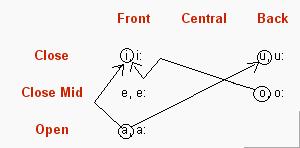Classical Diūn
| Classical Diūn | |
| Spoken in: | Diūn City-States |
| Time Period: | 200 YBK - 200 YSK(200 CE - 600 CE) |
| Total speakers: | extinct |
| Genealogical classification: | Proto-Diūn Classical Diūn |
| Basic word order: | SOV |
| Morphological type: | semi-fusional |
| Morphosyntactic alignment: | Ergative-Absolutive |
| Created by: | |
| Samuel Hopping | February 8, 2007- |
Classical Diūn was born on Thursday February 08, 2007 at 8:08:35 PM as Djún. It has also been known as Djūn and Djun.
I. Phonology:
A. Phoneme Inventory:
a. Consonants
| Bilabial | Alveolar | Postalveolar | Retroflex | Palatal | Velar | |
|---|---|---|---|---|---|---|
| Plosive | p, b | t, d | t`, d` | k, g | ||
| Nasal | m | n | n` | |||
| Fricative | p\, B | s, z | s`, z` | C | ||
| Affricate | ts | tS | ||||
| Approximant | r\ | j | ||||
| Lateral | l |
b. Consonant Orthography
| Bilabial | Alveolar | Postalveolar | Retroflex | Palatal | Velar | |
|---|---|---|---|---|---|---|
| Plosive | p, b | t, d | th, dh | c, g | ||
| Nasal | m | n | nh | |||
| Fricative | ph, bh / f, v | s, z | sh, zh | h | ||
| Affricate | ċ/cc | ch | ||||
| Approximant | r | i | ||||
| Lateral | l |
c. Vowels
| Front | Central | Back | |
|---|---|---|---|
| Close | i, i: | u, u: | |
| Close Mid | e, e: | o, o: | |
| Open | a, a: |
d. Vowel Orthography
| Front | Central | Back | |
|---|---|---|---|
| Close | i, ī | u, ū | |
| Close Mid | e, ē | o, ō | |
| Open | a, ā |
d. Diphthongs:
/ai au oi/ <ai au oi>
B. Allophones:
a. [J] occurs intervocalic as an allophone of /n/
b. [N] occurs in the coda of a syllable as an allophone of /n/
c. [tts] occurs intervocalic as an allophone of /ts/
d. [ttS] occurs intervocalic as an allophone of /tS/
e. [dZ] occurs intervocalic as an allophone of /g/
C. Phonotactics
a. No consonant clusters consisting of only fricatives,plosives or approximants
b. The coda and onset cannot consist of more than two consonant sounds
c. Approximants cannot begin a word. Approximants also have to have a Plosive or only the following fricatives infront of them /f v s z h/.
d. /r\/ cannot come after /p b k s z g/
e. retroflex consonants can only come at the end of a word
D. Syllable Structure
a. CV(C)
II.Grammar:
I. The Ergative Case
a. The Ergative Case marks the subject of a transitive verb. The Ergative Case is marked by the suffix, -(o)m.
b. The Ergative Pronouns are as follows:
Sihlem hiud ciīs cugi mo.
Eng: The worm went down into the earth
Tia toidan zado.
Eng: I see this man.
c. The Ergative Plural is expressed with the suffix, -(i)dom.
Sihledom toi haccēde.
Eng: Worms frighten me.
II. The Absolutive Case
a. The Absolutive case functions as the subject of intransitive verbs and the object of transitive verbs. The Absolutive case is unmarked by morphology but distinguished syntactically. The Absolutive case is also used as the object of postpositions.
b. The Absolutive pronouns are as follows:
Ci toidan vōmi mo.
Eng: He hit this man
Tia buhia Ċav he phīho.
Eng: I love the girl from Ċav.
c. The Absolutive plural is expressed with the suffix, (i)d.
Tia sihled zado mo.
Eng: I saw the worm

